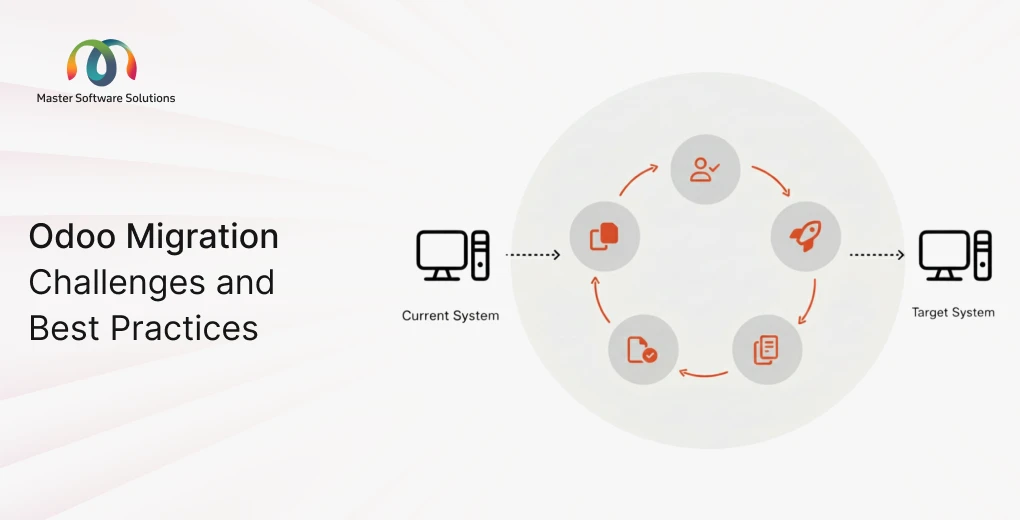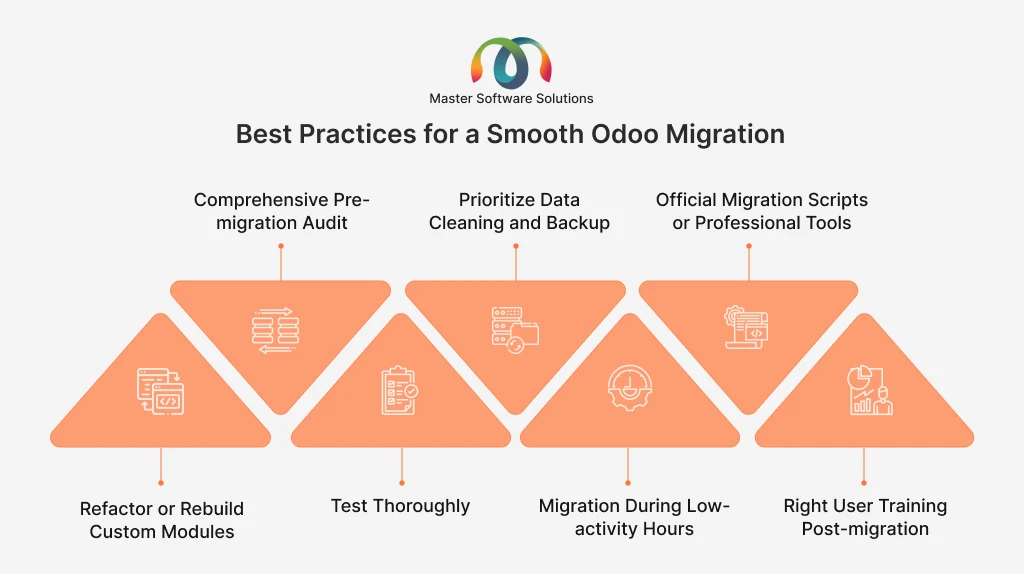Migrating to a new version of Odoo is more than just a technical upgrade; it is an opportunity for businesses to unlock improved performance, enhanced features, and better scalability. Migration to Odoo can be complex, especially for companies with extensive customizations, large datasets, or deeply integrated workflows. Without the right strategy, teams may encounter unexpected challenges, such as compatibility issues, data inconsistencies, and operational downtime.
This blog will break down the most common challenges organizations face during an Odoo migration and share proven best practices to ensure a smooth and successful transition.
Table of Contents
Understanding Odoo implementation
Odoo migration is the process of upgrading your existing Odoo environment, whether Community or Enterprise, to a newer version of the platform. As the Odoo release introduces new features, improved performance, and changes to the underlying architecture, migration ensures your system stays secure, efficient, and aligned with evolving business needs. Odoo migration consists of two major components:
Database migration
Every Odoo version stores and structures data differently. During migration, your existing database is transformed to match the new version’s schema. Proper database migration ensures that all your records, such as sales orders, inventory transactions, accounting entries, HR data, and customer information, transition smoothly with no loss or duplication. This includes:
- Updating field structures
- Re-mapping relational dat
- Converting deprecated models
- Ensuring data integrity across modules
Code and module migration
Odoo’s framework evolves with each release. This means older custom modules may not work as expected in newer versions. This step is crucial for businesses that rely heavily on tailored automations, integrations, or industry-specific functionalities. Code migration involves:
- Rewriting custom modules to fit the new API
- Adjusting logic to match updated workflows
- Replacing or refactoring deprecated functions
- Updating third-party add-ons for compatibility
Why does migration matter?
Odoo migration is more than just a technical task. It is a strategic investment that helps companies stay competitive and agile. Migration ensures your business benefits from:
- New features and UI enhancements
- Improved performance and security
- Updated localization and compliance
- Better integration possibilities
Defining the core Odoo migration process
A successful migration follows a structured approach designed to safeguard data integrity, maintain system performance, and preserve critical workflows. The core steps involved include:
Data extraction and transformation (ETL)
Migration begins with extracting data from the existing Odoo version, transforming it to align with the new database structure, and loading it into the upgraded system. This ETL process ensures that:
- All relevant records are preserved
- Deprecated fields are mapped correctly
- Data inconsistencies are cleaned before migration
Code and module refactoring
Custom modules and third-party add-ons often require modifications to function correctly in a newer version of Odoo. Refactoring includes
- Updating Python logic and XML views
- Replaced deprecated APIs or frameworks
- Adjusting the custom workflow to align with updated features
Integration validation and deployment
Odoo commonly integrates with payment gateways, e-commerce platforms, BI tools, and other business applications. During migration, these integrations must be validated to ensure:
- APIs remain functional
- Business processes continue uninterrupted
- External connectors are compatible with the upgraded version
Key challenges faced in the Odoo migration
Migrating to a new version of Odoo offers significant benefits, but the process also presents several challenges that businesses must anticipate and manage effectively. Understanding these obstacles upfront helps ensure a smoother and more predictable migration journey.
Data migration complexities
One of the biggest challenges in Odoo migration involves handling large volumes of business-critical data. Differences in database structures between Odoo versions often require extensive data mapping and transformation. Ensuring data integrity requires a combination of careful extraction, cleansing, and thorough post-migration validation. Without careful planning, businesses risk:
- Missing records
- Data duplication
- Corrupted entries
- Failed relational mapping
Integration issues: existing and third-party apps
Many organizations rely on integrations with payment gateways, logistics systems, BI tools, e-commerce platforms, or custom APIs. Fixing these issues can be time-consuming and may require custom development or replacement of outdated connectors. During migration, these integrations can break due to:
- Version mismatches
- API changes
- Deprecated connectors
- Modified authentication mechanisms
Customization and compatibility issues
Businesses that rely heavily on custom modules often experience compatibility issues when upgrading. These conflicts can cause errors, system crashes, or inconsistent behavior, making module refactoring a crucial part of the migration process. Common challenges may include:
- Outdated functions or methods
- Deprecated frameworks or widgets
- Changes in Odoo’s core logic
- Conflict between custom modules and newer system features
User adoption and training resistance
Even if the technical migration is flawless, user adoption can still be a barrier. Insufficient training can reduce productivity and create frustration, making change management and communication essential. Employees may resist changes due to:
- A redesigned interface
- New workflows
- Updated features
- Lack of training or confidence
Minimizing system downtime and business disruption
Migration often requires taking the system offline for a certain period. A strategic migration window and contingency planning are crucial to avoid major disruptions. Poorly planned downtime can:
- Interrupt daily operations
- Delay orders or transactions
- Affect customer service
- Cause financial losses
Managing budget and cost overruns
Without clear scoping and expert guidance, costs can escalate quickly, especially for larger or heavily customized environments. Migration projects sometimes exceed the initial budget due to:
- Hidden customization complexities
- Unplanned data cleaning
- Integration fixes
- Extended testing cycles
Performance issues post-migration
Managing post-migration issues necessitates meticulous monitoring, debugging, and performance tuning. After migration, some businesses encounter performance drops or unexpected system bugs, often caused by:
- Unoptimized database queries
- Poorly refactored custom code
- Missing indexes
- Increased load on updated modules
- Incomplete testing before deployment
Post-migration activities
To ensure your upgraded Odoo system delivers optimal performance and meets business expectations, several key post-migration activities must be completed. These steps help stabilize the environment, refine workflows, and support user adoption.
Performance monitoring
After migration, the system may behave differently due to changes in code, database structures, or server configurations. Closely tracking system performance in the days following migration, businesses can quickly detect and resolve bottlenecks before they impact operations. Continuous performance monitoring helps identify issues such as:
- Slow page loading
- Unoptimized queries
- High-server resource usage
- Delayed workflows or background jobs
Data validation
Even with careful ETL processes, validating the integrity and accuracy of migrated data is essential. This step ensures your business can continue operating with confidence and precision. Data validation includes:
- Verifying that all records (sales, inventory, accounting, HR, etc.) are transferred correctly
- Ensuring relational data is intact
- Checking reports, balances, and transactional histories
- Confirming no data is missing, duplicated, or corrupted
Fine-tuning custom workflows
Migrating to a newer version often introduces changes in features, logic, and interface behaviour. As a result, custom workflows may need refinement to align with the updated system. Optimizing workflows post-migration helps improve efficiency and reduce friction for end-users. Activities include:
- Adjusting automation rules
- Updating business logic
- Enhancing UI components
- Eliminating redundant steps using new Odoo features
Continuous user feedback loop
Successful migration extends beyond technology. It also depends on user satisfaction. Organizations can continuously improve systems, increase productivity, and drive higher user adoption by analyzing and acting on this feedback. Establishing a feedback loop allows employees to report:
- Usability issues
- Feature gaps
- Missing customizations
- Suggestions for improvements
Best practices for a smooth Odoo migration
Successfully migrating to a newer version of Odoo requires more than technical expertise. It demands strategic planning, careful execution, and continuous validation. By following proven best practices, businesses can minimize risks and ensure a seamless upgrade experience.
Conduct a comprehensive pre-migration audit
A successful migration begins with a deep understanding of your current odoo environment. This step allows you to forecast challenges early, estimate accurate migration costs, and create a realistic timeline. A pre-migration audit helps identify:
- Installed modules (standard, custom, and third-party)
- Integrations and external dependencies
- Data quality and volume
- Workflows and business processes
- Potential compatibility issues
Prioritize data cleaning and backup
Before performing any migration, it’s essential to clean and back up your data. Cleaning data increases migration success and reduces post-migration errors. This includes:Removing duplicated or outdated records.
- Correcting data inconsistencies
- Archiving unnecessary data to reduce migration load
- Taking multiple full backups to safeguard against data loss
Use official Odoo migration scripts or professional tools
Odoo’s official tools, such as the OpenUpgrade framework, help automate database conversions and reduce manual intervention. Odoo certified partners, such as Master Software Solutions, ensure accuracy and prevent unexpected failures for complex environments. These tools can:
- Adapt data models to new structures
- Handle deprecated fields
- Streamline schema transformation
Refactor or rebuild custom modules
Custom modules often break during migration if not updated to meet the latest Odoo standards. In some cases, rebuilding a module from scratch may be more efficient than refactoring outdated code. Best practices include:
- Updating deprecated methods
- Rewriting incompatible logic
- Replacing outdated UI components
- Reviewing workflows for efficiency improvements
Test thoroughly
Testing is one of the most critical phases of Odoo migration. Testing in a staging or sandbox environment helps catch issues before they impact real operations. A thorough testing approach involves:
- Unit testing to validate individual components
- Functional testing to ensure workflows operate as expected
- User Acceptance Testing (UAT) to gather real-world feedback
- Performance testing to identify bottlenecks
Plan migration during low-activity hours
To minimize downtime and business disruption, schedule the final migration during periods when system usage is lowest, such as weekends or off-hours. Proper scheduling is critical to ensuring continuity. This:
- Reduces operational impact
- Provides more time to resolve unexpected issues
- Allows users to start fresh with minimal interruptions
Ensure the right user training post-migration
The new version of Odoo often brings UI upgrades, feature enhancements, and workflow changes. Effective user training reduces resistance to change and boosts overall productivity after migration. To ensure smooth adoption, provide:
- Hands-on training sessions
- Detailed user guides or video tutorials
- Support channels for quick issue resolution
- Gradual onboarding to new features
Conclusion
Migrating to a newer version of Odoo is a powerful opportunity for businesses to modernize their operations, enhance performance, and unlock new features. However, the process comes with its own set of challenges, including data migration complexities, customization conflicts, and user adoption hurdles. With careful planning, the right tools, and a focus on user experience, organizations can fully leverage the capabilities of Odoo and position themselves for scalable, future-ready growth.
Master Software Solutions is a certified Odoo migration company with a team of 50+ Odoo-certified professionals who understand multiple industries and can help businesses with the seamless Odoo migration process. We offer one-stop Odoo migration services, including Odoo app migration, data migration, module migration, migration testing, migration from the legacy system, server migration, and new version upgrades.
Want to avoid downtime, data loss, and costly migration errors? Schedule a free consultation and get a tailored Odoo migration strategy for your business.

